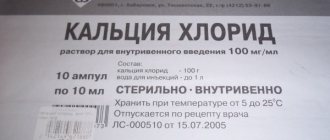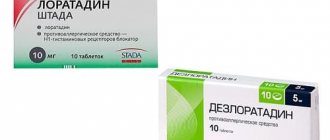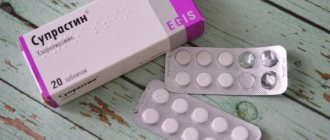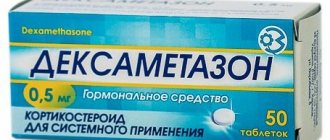Category: Published 04/17/2019 · Comments: · Reading time: 4 min · Views: 1,666
An antihistamine, a blocker of histamine H1 receptors, is Chloropyramine. The instructions for use indicate that 25 mg tablets and injections in injection ampoules help with allergies, urticaria, rashes in adults, children and pregnancy. Why Chloropyramine is prescribed, prices, reviews from patients and doctors, as well as analogues of the drug will be discussed in the article.
Release form and composition
The drug Chloropyramine is available in dosage form, a solution for parenteral (intramuscular or intravenous) administration, as well as tablets for oral administration.
The solution is transparent and has a light yellow color.
The tablets have a round shape, flat-cylindrical surface and white color. The main active component of the drug is chloropyramine hydrochloride, its content in 1 ml of solution is 20 mg, in 1 tablet – 25 mg.
Chloropyramine solution is contained in glass ampoules of 1 ml, which are packaged in blister packs of 5 pieces, tablets in a blister of 25 pieces. The cardboard pack contains one blister pack with ampoules or a blister with tablets, as well as instructions for use.
Analogues of the drug
For almost any medication, you can choose medications that can replace it. The drug "Chloropyramine" is no exception.
Analogues of this medicine:
- "Suprastin".
- "Chloropyramine-Ferein".
- "Suprastilin".
- "Chloropyramine hydrochloride."
- "Chloropyramine-ESKOM".
All these drugs can effectively replace the original drug. However, remember that only with a doctor should you select a drug that can become an alternative to the drug “Chloropyramine”.
The analogues given above contain the same active ingredient as the original product. Therefore, if you have hypersensitivity to such a component, these drugs are also not suitable.
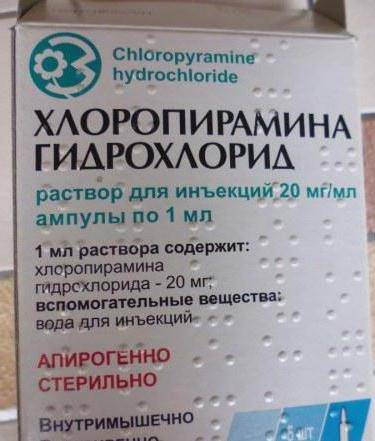
pharmachologic effect
The therapeutic effect of Chloropyramine is explained by its ability to block the activity of histamine H1 receptors and m-cholinergic receptors. The drug has antipruritic, antiallergic, antispasmodic, sedative, hypnotic and anticholinergic effects on the body.
The active substance Chloropyramine is able to block the spasmodic effect of histamine on the smooth muscles of the bronchi and intestines, thereby reducing the hypotensive effect of histamine and its effect on vascular permeability. The pharmacological action of the drug is also aimed at preventing the development of allergic reactions and alleviating their course.
The maximum concentration of Chloropyramine in the blood is observed 2 hours after taking the drug, and the therapeutic effect lasts for 4-6 hours.
Chloropyramine tablets
The drug was created to combat allergies and belongs to the group of histamine H1 receptor blockers. It has a sedative effect, eliminates itching, swelling of the nasal mucosa, reduces spasms of smooth muscles and bronchi. Used in the treatment of diseases such as conjunctivitis and allergic rhinitis. Effective for dermatoses. Relieves symptoms of anaphylactic reactions. The tablets are well absorbed, the drug quickly spreads throughout the body and is easily eliminated. It has low cost and long duration of action. Chloropyramine in Latin: Chloropyramine.
Composition and release form
The medication is sold in pharmacies in two forms: tablets and injection solution (administered intravenously or intramuscularly). Packaging: 20 tablets, each containing 25 mg of active substance. The solution is a clear liquid, packaged in ampoules, has a greenish or yellowish tint, with a specific odor. Contains 20 mg of active substance. Packaging: from 5 to 10 ampoules:
| Pills | 1 PC. |
| Active substance: Chloropyramine hydrochloride. | 25 mg |
| Excipients starch, milk sugar, magnesium stearate, talc. | |
| Solution | 1 ml |
| Active substance: Chloropyramine hydrochloride. | 20 mg |
| Water for injections | ? |
Pharmacological properties
The drug relieves allergies, gives hypnotic antihistamine, sedative, anticholinergic, antispasmodic effects. The tablet has an effect due to the blockade of histamine H1 receptors and m-cholinergic receptors, and reduces capillary permeability. By blocking histamine, the drug changes vascular permeability, reduces the spasmogenic effect of this substance, affecting the intestines and smooth muscles of the bronchi, and relieves the hypotensive effect.
The drug relieves itching, improves sleep, and is used as a sedative. When taken orally, Chloropyramine is rapidly and almost completely absorbed. Two hours after administration, the concentration of the drug in the blood becomes maximum and remains so for several (but not more than six) subsequent hours. According to the instructions, the drug is able to penetrate the blood-brain barrier, distributes throughout the body, and is processed by the liver. The drug is eliminated through the intestines and kidneys.
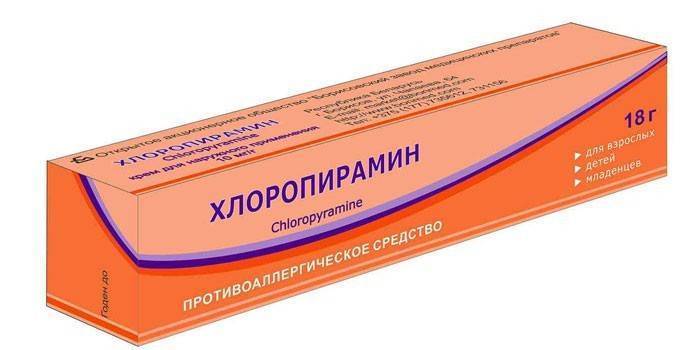
Indications for use
The medication is considered a powerful antihistamine that helps fight seasonal allergies and dermatitis. According to the instructions, the tablets and solution have the following indications:
- hay fever;
- conjunctivitis of allergic origin;
- vasomotor rhinitis;
- allergy to pills;
- hives;
- Quincke's edema;
- bronchial asthma (mild form);
- skin problems (neurodermatitis, dermatitis (atopic and contact), toxicoderma, eczema);
- serum sickness;
- itching (from an insect bite);
- Acute respiratory infections (dry nasopharyngeal mucosa, hypersecretion).
Indications for use
What does Chloropyramine help with? Tablets and injections are prescribed if the patient has:
- hives;
- drug allergies;
- itching from insect bites;
- skin diseases (eczema, neurodermatitis, atopic and contact dermatitis, toxicoderma);
- mild bronchial asthma;
- serum sickness;
- hay fever;
- acute respiratory diseases (“drying” effect on mucous membranes);
- Quincke's edema;
- vasomotor rhinitis;
- allergic conjunctivitis.
Instructions for use
Chloropyramine tablets
When taken orally, adults - 25 mg 3-4 times a day, children, depending on age - 6.25-12.5 mg 2-3 times a day. The maximum dose for adults is 150 mg per day.
Ampoules
Intravenously or intramuscularly. Adults are prescribed 20-40 mg per day (contents of 1-2 ampoules). Treatment in children begins with a dose of 5 mg (0.25 ml). Subsequently, the dose is increased depending on the age of the child.
- Children aged 1-12 months - 5 mg (0.25 ml).
- Children aged 1-6 years - 10 mg (0.5 ml).
- Children aged 7-18 years - 10-20 mg (0.5-1 ml).
The daily dose should not exceed 2 mg/kg body weight. In case of severe allergies, treatment should begin with an injectable form of chloropyramine. At first it is administered intravenously slowly, then they switch to intramuscular administration and in the final phase of treatment they switch to taking tablets orally.
The duration of treatment is determined individually depending on the clinical symptoms and condition of the patient. Elderly, debilitated patients: the use of the drug chloropyramine requires special caution, because in these patients, antihistamines are more likely to cause side effects (dizziness, drowsiness).
Patients with impaired liver function: a dose reduction may be required due to a decrease in the metabolism of the active component of the drug in liver diseases. Patients with impaired renal function: a change in the dosage regimen and a dose reduction may be required due to the fact that the active component is mainly excreted through the kidneys.
Features of the drug
Chloropyramine is a first generation antihistamine produced by Russian pharmaceutical companies, Sotex.
Dosage forms
Chloropyramine is presented by the manufacturer in two release forms:
- tablets for oral administration 0.25 mg, packaged in a jar in the amount of 20 pieces;
- ampoules with an injection solution of 1 ml, packed in a box in the amount of 5 pieces.
Composition of Chloropyramine
The main substance of the drug is chloropyramine hydrochloride, a histamine receptor blocker. In pharmacology, it is included in the list of drugs labeled “vital”.
Excipients of Chloropyramine are:
- talc is an absorbent;
- lactose – filler;
- magnesium stearate – necessary to impart viscosity;
- talc - used to protect the mucous membranes when taking tablets.
The composition of the drug in ampoules for injections is a combination of chloropyramine hydrochloride and distilled water.
Contraindications
Numerous medical reviews about Chloropyramine warn of a number of contraindications for which taking the drug is highly not recommended:
- exacerbation of gastric ulcer;
- acute attacks of bronchial asthma;
- pregnancy and lactation;
- prostatic hyperplasia;
- children less than 1 month old;
- combination of taking the drug with MAO inhibitors;
- hypersensitivity to the components of the drug, in particular to ethylenediamine derivatives (including chloropyramine).
By
What can replace the drug?
Instead of Chloropyramine, other drugs are often prescribed that are analogous to it either in the active substance or in the medicinal effect.
Table: brief overview of Chloropyramine analogues
| Name | Release form | Active ingredient | Indications | Contraindications | At what age can the drug be used? | Prices for the product in Russian pharmacies |
| Suprastin |
| Chloropyramine. | Despite their different compositions, all of these drugs are H1-histamine receptor blockers. Therefore, the indications for their use are the same. They are listed in the “Indications for use” block. | Suprastin and Chloropyramine are based on the same substance, so the contraindications for their use are the same. They are listed in the “Contraindications” block. |
| Packaged:
|
| Tsetrin | Pills. | Cetirizine. |
| From 6 years old. | Packaged:
| |
| Claritin |
| Loratadine. |
|
| Packaged:
| |
| Diazolin |
| Mebhydrolin. |
| From 3 years. | Packaged:
|
Photo gallery: drugs with similar pharmacological effects
Suprastin is a Hungarian analogue of Chloropyramine, produced in Russia
Cetrin is a second-generation antiallergic drug, so it does not have a hypnotic or sedative effect.
Claritin is another second-generation antiallergic drug that is convenient to give to children in the form of syrup.
Diazolin is a domestic first-generation antiallergic drug, like Chloropyramine
Video: comparison of Chloropyramine with its analogues
Side effects
Before starting to use the drug, it is important to read the instructions for Chloropyramine, because During treatment, undesirable effects may occur. Their list is presented below:
- in rare cases, arrhythmia, tachycardia may occur, and there is also a possibility of increased blood pressure;
- dry mouth, constipation, diarrhea, vomiting, nausea;
- allergies in the form of itching and skin rash;
- difficulty urinating;
- drowsiness, lethargy, weakness, slight tremor of the limbs. Side effects in children can manifest themselves in the form of agitation, anxiety, insomnia, and irritability.
Table: possible side effects
| The organ system from which side effects develop | List of adverse reactions |
| urinary system | Dysuria (difficulty urinating). |
| Gastrointestinal tract |
|
| CNS | In adults:
In children it is possible:
|
| The cardiovascular system |
|
| Visual analyzer | Increased IOP (intraocular pressure). |
| The immune system | Allergic reactions:
|
| Hematopoietic system |
|
| Others |
|
Children, pregnancy and breastfeeding
Chloropyramine is contraindicated during pregnancy and lactation.
Use in children
Treatment in children begins with a dose of 5 mg (0.25 ml). Subsequently, the dose is increased depending on the age of the child.
- Children aged 1-12 months (infants) - 5 mg (0.25 ml).
- Children aged 1-6 years - 10 mg (0.5 ml).
- Children aged 7-18 years - 10-20 mg (0.5-1 ml).
The daily dose should not exceed 2 mg/kg body weight. Contraindicated in early childhood up to 1 month. Use with caution in children due to the increased sensitivity of this category of patients to antihistamines.
Overdose
Chloropyramine analogues, like the drug itself, can cause an overdose of the drug if used in quantities exceeding those recommended by the instructions for Chloropyramine. Symptoms of overdose are:
- in children - anxiety, the appearance of hallucinations, athetosis, ataxia, convulsions, mydriasis, pupil realignment, facial skin flushing, hyperthermia. In rare cases - collapse, coma;
- in adults - a state of depression and lethargy, or, conversely, excitation of the central nervous system, sometimes - the appearance of hallucinations, coordination disorders, as well as hyperthermia and lack of reaction to light from the pupils.
To reduce or remove the above signs of overdose, systematic therapy is used, including taking phenamine, antiepileptic drugs, caffeine, and resuscitation measures are also carried out simultaneously with ventilation. To date, there is no specific antidote that can help in this situation.
special instructions
Before prescribing Chloropyramine tablets or solution, the doctor must carefully study the instructions for the drug and pay attention to several important features of its correct use:
- Taking Chloropyramine tablets shortly before bedtime can cause the development of reflux esophagitis (inflammation of the mucous membrane of the esophagus, caused by the reverse reflux of stomach contents).
- The drug can mask the manifestations of the negative effects of ototoxic drugs on the hearing organ.
- The use of this drug may distort the results of skin allergy tests.
- This drug may interact with drugs from other pharmacological groups (sedatives, tranquilizers), so you should warn your doctor about their possible use.
- Long-term use of antihistamines, which include the drug Chloropyramine, can lead to impaired hematopoiesis, which requires periodic monitoring of the status of peripheral blood parameters.
- Since the active substance of the drug can have a sedative therapeutic effect, while using it, you should avoid potentially dangerous activities that require increased concentration and speed of psychomotor reactions.
Avoid drinking alcohol during the course of drug therapy, as this can lead to a significant sedative effect.
Overdose
If you take pills randomly, without following the recommendations, you can cause an overdose
It is important to go to the clinic to have a gastric lavage done, take sorbents, antiepileptic drugs, and caffeine. An overdose of tablets is indicated by symptoms that occur during atropine intoxication:
- Children: become excitable, have panic attacks, anxiety, hallucinations, possible convulsions, dilated pupils, hyperthermia, vascular collapse, involuntary twitching of the arms or legs, bronchospasm.
- Adults: psychomotor agitation, retardation, clouding of consciousness, convulsions and vascular collapse.
Analogues of the drug Chloropyramine
Analogues are determined by structure:
- Chloropyramine hydrochloride.
- Suprastin.
Antihistamines include analogues:
- Allegra.
- Parlazin.
- Tavegil.
- Pipolfen.
- Cetrin.
- Erespal.
- Claritin.
- Telfast.
- Histaphene.
- Erius.
- Erispirus.
- Cetirizine.
- Fenistil.
- Fexofenadine.
- Histaglobin.
- Gismanal.
- Xizal.
- Diphenhydramine.
- Suprastin.
- Zodak.
- Gistalong.
- Aviamarin.
- Lomilan.
- Suprastinex.
- Zyrtec.
- Allergodil.
- Fenspiride.
- Nalorius.
- Clemastine.
- Desal.
- Reactin.
- Loratadine.
- Siresp.
- Allertek.
- Levocetirizine.
- Erolyn.
- Mebhydrolin.
- Allergoferon.
- Donormil.
- Desloratadine.
- Pheniramine maleate.
- Astemizole.
- Doxylamine succinate.
- Ezlor.
- Kestin.
- Diazolin.
Vacation conditions and price
The average cost of Chloropyramine (20 mg/ml ampoules, 1 ml, 5 pieces) in Moscow is 100 rubles. In the pharmacy chain, tablets and solution for parenteral use Chloropyramine are available with a prescription. Their uncontrolled use is not recommended, as this can lead to negative health consequences.
The shelf life of tablets and solution for parenteral administration is 3 years from the date of manufacture. Freezing the solution should be avoided. The instructions for use recommend storing the drug Chloropyramine only in the original original packaging, in a dark, dry place, out of reach of children, at an air temperature not exceeding +25° C.
Price
Chloropyramine is not a prescription drug. It can be bought at a pharmacy without a doctor's prescription. The price of Chloropyramine varies from 100 -120 rubles. The drug in ampoules is cheaper - up to 100 rubles. This price category makes the drug accessible to the general population.
Chloropyramine is an inexpensive and effective drug prescribed to adults and children to relieve allergy symptoms. The main component of the medicine rarely causes side effects, so the product is approved for use in children from 1 month. Exceeding the dosage may cause problems with the digestive system and the central nervous system, so before using the medication you should read its description.
The drug has many analogues with a similar composition. However, before replacing one remedy with another, you should consult a specialist.
